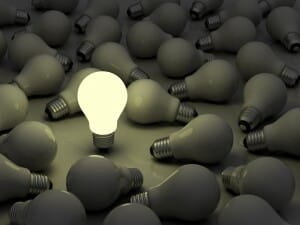Creativity and Divergent Thinking
Creativity can be difficult to define and even more difficult to facilitate. Teams expert, Leigh Thompson, says the following about creativity in her book Making the Team: A Guide For Managers: “Team creativity is the Holy Grail of teamwork: Everyone wants it, but very few people know where to look for it or how to set up the conditions to make it happen.” Creativity and divergent thinking work hand in hand in this process.
Definitions of Creativity
Individuals and groups may generate unusual ideas that might even border on the bizarre; but if those ideas have no practical use, they are of limited value. Creative ideas that are original and usable, however, don’t have to be of the magnitude of an Einstein, Picasso, or Da Vinci to be creative. The same process that creates a Mona Lisa can generate a brilliant new marketing strategy or innovative way to reduce expenses. Creative solutions lead to innovation and change because they are able to go beyond existing perspectives.
E. Paul Torrance, a dominant figure in the field of creativity research, is well-known for the development of creativity assessments. His assessments are the gold standard in educational settings (elementary, secondary, and post-secondary) and non-educational settings alike. Torrance defines creative thinking as “the process of sensing difficulties, problems, gaps in information, missing elements, something askew; making guesses and formulating hypotheses about these deficiencies; evaluating and testing these guesses and hypotheses; possibly revising and retesting them; and finally communicating the results.”
Thus, the first step in the creative process is seeing the problem accurately. The nature of a problem is one of the most important components of the creative process. After all, identifying and defining the problem determines the quality and effectiveness of the solution.
Divergent Thinking In Teams
Many theorists associate creativity with divergent thinking or the ability to generate multiple perspectives and unconventional ideas. Old conceptualizations and judgments are suspended in favor of generating a variety of possibilities. Divergent thinking is expansive and resists convention; it looks for alternatives that are not often apparent at first glance.
For example, when asked to identify all the possible uses of a toothbrush, the most obvious answers have to do with cleaning teeth or other surfaces because that’s what we think of when we picture a toothbrush in our mind. But someone who is using divergent thinking might envision a toothbrush as a director’s baton, or a paintbrush, or a back scratcher. These answers are outside the conventional “box” that is normally associated with the concept of a toothbrush and, thus, qualify as divergent perspectives.
Those who can think divergently have less rigid and less structured internal categories. This is important because individuals and teams that resist convention and expand their thinking have more possibilities to consider in solving any particular problem. Thinking outside the box requires the ability to question assumptions and take risks, and because divergent thinking could be considered a “risk-taking behavior,” finding divergent thinking in teams can be difficult.
Four Types of Divergent Thinking
According to influential US psychologist J.P. Guilford, there are four different ways to think divergently.
Fluency
Fluency is the ability to produce a large number of ideas for understanding or solving problems. For example, the iPod design team might have come up with 40 different music player platforms and delivery systems that they needed to consider before settling on the iPod.
Flexibility
Flexibility is the ability to produce ideas in a variety of categories. The iPod designers might have considered a number of music delivery systems including hardware solutions, software solutions, and phone-based platforms. These three categories are very different from each other and demonstrate flexibility.
Originality
Originality is the ability to produce unusual or unique ideas. If the design team suggested a variation of existing technology, it would not be very novel. A more original idea was for designers to think outside the box for a system that went far beyond existing MP3 players.
Elaboration
Elaboration is the ability to develop ideas by generating details and depth. Creative ideas may not seem very usable at first glance. Elaboration is the ability to develop abstract ideas into realistic solutions that can be implemented successfully. For example, in order to bring their product to market, the iPod design team had to create an innovative manufacturing process that advanced technology while keeping costs within reasonable levels.
Conclusion
The most vexing problems facing groups today resist easy answers. A common maxim in the business world is that today’s problems are often the result of yesterday’s solutions. Groups that encourage creativity are able to avoid superficial solutions by generating and evaluating a greater number of possibilities. Divergent thinking helps groups consider a plethora of possible outcomes that can lead to better outcomes.


